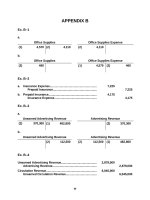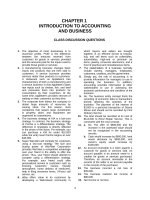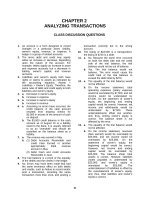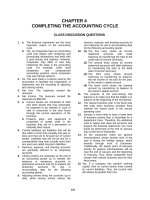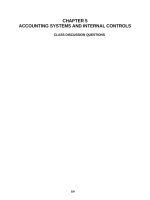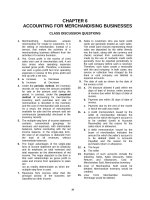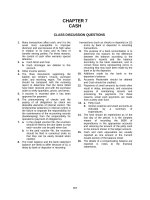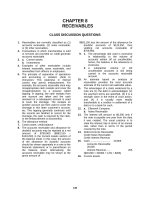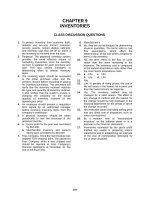Solution manual investments 10th by jones ch17
Bạn đang xem bản rút gọn của tài liệu. Xem và tải ngay bản đầy đủ của tài liệu tại đây (59.2 KB, 16 trang )
PART VI:
DERIVATIVE SECURITIES
Chapter 17:
Options
CHAPTER OVERVIEW
Chapter 17 is a complete and detailed analysis of options-puts and calls--including market index options. It is designed
to cover all the terminology and trading mechanics as well as
considerable analytics involving the valuation and use of
options. It can be used with software for solving the BlackScholes call option model, although use of the software is
optional because complete examples are presented to illustrate
the model. Such concepts as put-call parity and hedge ratios
also are covered. Overall, this chapter is a comprehensive
treatment of options from the standpoint of the typical
undergraduate student. It is also a very lengthy chapter.
The first few pages of the chapter provide the necessary
background information, including terminology and an analysis of
exactly how options work, with an extended example. The
mechanics of trading also are covered, including a detailed
description of the role of the clearing corporation, margin, and
brokerage commissions.
The payoffs and profits from basic option positions are
analyzed in detail, using graphs, in order for students to
clearly understand how options can be used and how they change
the distribution of potential outcomes in ways that could not
readily be accomplished (if at all) without the use of options.
Each of the four basic cases is analyzed, buying a call and
buying a put, and selling (writing) a call and selling a put.
Somewhat more sophisticated options strategies are examined in a
briefer format in Appendix 17-A by considering straddles, strips,
straps, and spreads. While the basics are covered here, the
instructor may choose to augment this discussion. At the
beginning level, however, it is sufficient as presented.
Considerable attention is devoted to option pricing. The
discussion begins with a general framework of in-the-money and
out-of-the money conditions, and the resulting intrinsic value of
an option. The speculative premium is then developed. Examples
245
are used in all cases, and these examples are based on option
prices as might be seen in The Wall Street Journal.
The next part of the discussion on option pricing develops
the boundaries on option prices in graph format, which provides a
framework for understanding actual option prices. This
discussion leads into the Black-Scholes model, which is developed
in a detailed but understandable format. All of the variables
are explained, and a comprehensive example illustrates the
calculations. Following this, the idea of hedge ratios is
developed, and the put-call parity relationship presented.
Having developed all of the above, the chapter proceeds to
explain what puts and calls mean to investors in terms of
truncating the distribution of potential returns and the concept
of purchasing insurance. This is followed by a discussion of
portfolio insurance, with a detailed example that clearly
illustrates this often-talked about concept. Finally, the
evolutionary use of options is discussed, as we consider how
institutions are using options.
Chapter 17
index options.
Strategies with
investors might
portfolios.
concludes with a thorough discussion of stock
Basics are covered, and examples given.
stock index options are developed, showing how
use these instruments in managing their
Appendix 17-A covers spreads and options. This material is
placed in an appendix because Chapter 17 is a long chapter, and
this material is not absolutely necessary for students to obtain
a basic knowledge of options.
Appendix 17-B contains a quite-detailed discussion of
warrants for those who wish to cover this subject.
CHAPTER OBJECTIVES
To present the necessary background--terminology and
mechanics--to thoroughly understand puts and calls.
To explain uses of, and strategies with, options.
246
To explain the pricing of options.
To present a complete basic discussion of stock index
options.
247
MAJOR CHAPTER HEADINGS [Contents]
Introduction
[definitions; why options markets?]
Understanding Options
Options Terminology
[strike price, expiration date, option premium; LEAPS;
reading The Wall Street Journal]
How Options Work
[detailed examples of buying and selling calls and puts]
The Mechanics of Trading
[secondary markets; the clearing corporation]
Payoffs And Profits From Basic Option Positions
Calls
[buying a call; selling a call; diagrams]
Puts
[buying a put; writing a put; diagrams]
Some Basic Options Strategies
Covered Calls
[explanation and example; diagram]
Protective Puts
[explanation and example; diagram]
Portfolio Insurance
[explanation; discussion; example; costs]
248
Option Valuation
A General Framework
[in the money and out of the money definitions]
Intrinsic Values and Time Values
[intrinsic value definition and examples]
Boundaries on Option Prices
[graphical illustration of how boundaries are established]
The Black-Scholes Model
[model variables and equations; analysis of the inputs;
complete example]
Put Option Valuation
[using put/call parity to derive the price of a put]
Summarizing the Factors Affecting Options Prices
[effects of various variables on put and call prices]
Hedge Ratios
[definition; example]
Using the Black-Scholes Model
[brief analysis of the evidence]
An Investor’s Perspective on Puts and Calls
What Puts and Calls Mean to Investors
[truncating the distribution of returns]
The Evolutionary Use of Options
[institutional trends; use in strategic portfolio
management]
Stock Index Options and Interest Rate Options
[mention of interest rate options]
The Basics of Stock Index Options
[what is available; differences from stock options; example]
249
Strategies with Stock Index Options
[example of buying a call; example of buying a put]
The Popularity of Stock Index Options
Appendix 17-A
Spreads and Combinations
Appendix 17-B
Warrants
POINTS TO NOTE ABOUT CHAPTER 17
Tables and Figures
Table 17-1 analyzes how the relevant variables affect both
put and call prices.
Figures 17-1 through 17-5 illustrate the basic options
strategies (buying and writing puts and calls) and can be used to
emphasize important points about the distribution of returns.
Both the payoff profiles and the profit and losses are shown for
each case.
Figure 17-6 shows the payoff profiles for a covered call
position, while Figure 17-7 shows the profit and loss
possibilities for a covered call position.
Figure 17-8 illustrates the payoff profile and profit/loss
possibilities for a protected put position.
Figure 17-9 illustrates the boundaries on option prices.
Box Inserts
Box 17-1 is a good popular press discussion of how to use
puts to protect positions during a bear market. It has a good
general discussion of options, an effective analysis of puts, and
very clear examples.
250
ANSWERS TO END-OF-CHAPTER QUESTIONS
17-1.
Puts and calls are short-term options, with maturities
(on organized exchanges) measured in months. Warrants
generally have maturities of several years, and a few are
perpetual.
A second distinction is that puts and calls are created
by investors (individuals or institutions), while
warrants are created by corporations.
Finally, every warrant is unique, with the corporation
(issuer) setting its parameters on a case-by-case basis.
17-2.
17-3.
The potential advantages of puts and calls include:
(a)
the smaller investment required relative to
transacting in the common
(b)
leverage--potential magnification of gains
(c)
maximum loss is known in advance
(d)
an expanded opportunity set, increasing the riskreturn combinations available.
(e)
possible lower transactions cost for the portfolio
as a whole
(f)
the ability to hedge or speculate on broad market
movements and/or interest rates using index options
(a)
Strike or exercise price--the per-share price at
which the common stock may be purchased (or sold to
a writer)
(b)
Naked option--a call option written without the
stock being owned by the writer, or a put option
written by a writer who is not short the stock
(c)
Premium--the price paid by the option buyer to the
writer or seller of the option--the market price of
the option
251
(d)
Out-of-the-Money Option--a call whose exercise
price exceeds the current stock price or a put
whose exercise price is less than the current stock
price.
17-4.
Investors, both individuals and institutions, write puts
and calls in an attempt to profit from their beliefs
about the underlying stock’s likely price performance.
Writers earn the premiums paid by the buyers.
17-5.
The options clearing corporation (OCC) plays an important
role in the options market. The OCC guarantees the
performance of the contracts, preventing potential
problems with writers who must honor their obligations.
The OCC facilitates the taking of an opposite (closing)
position at any time by buyers or sellers.
17-6.
Option prices almost always exceed intrinsic values.
This excess, sometimes called the premium over parity,
exists because buyers are willing to pay some price for
potential future stock price movements.
17-7.
Option prices almost always exceed intrinsic values, with
the difference reflecting the option’s potential
appreciation typically referred to as the time value.
Time obviously has a positive value for call options
because the longer the time to expiration for a call
option, the more chance it has to appreciate.
17-8.
The Black-Scholes model uses five variables to value a
call option:
(a)
(b)
(c)
(d)
(e)
the
the
the
the
the
price of the underlying stock
exercise price of the option
time remaining to the expiration of the option
riskless rate of return
volatility of the underlying stock price.
The first two variables determine whether an option is
in-the-money or not. A difference between (a) and (b)
that results in an in-the-money option has a direct
(positive) effect on the option’s value.
252
The last three factors, (c) through (e), have a direct
(positive) effect on an option’s value.
17-9.
17-10.
Reasons for purchasing a call are:
(a)
to establish a position with minimum initial
investment
(b)
to protect a short sale
(c)
to maximize leverage for speculative purposes
(d)
to engage in hedging strategies.
Investors writing calls often are seeking the income from
the premium. Such a strategy can supplement the dividend
income on stocks held.
The obligation of a call writer is to deliver the stock
for the strike price if called upon to do so.
17-11.
A straddle (see Appendix 17-A) is a combination of a put
and a call on the same stock with the same exercise date
and exercise price.
A straddle buyer believes that the underlying stock price
is highly volatile, and may go either up or down. Since
each part of the straddle can be exercised separately, a
buyer can profit from a large enough move either way.
17-12.
A spread (see Appendix 17-A) is defined as the purchase
and sale of an equivalent option varying in only one
respect (exercise price or expiration date). The purpose
of a spread is to reduce risk in an option position.
17-13.
Two types of spreads are (see Appendix 17-A):
(a)
A money spread involves the purchase of a call
option at one exercise price and the sale of the
same maturity option, but a different exercise
price.
(b)
A time spread involves the purchase and sale of
options identical except for expiration dates.
253
17-14.
The call or put writer’s position is considerably
different from the buyer’s position because of the
obligation involved on the part of a writer. A call
writer must be prepared to deliver the stock, regardless
of the level to which the stock price has risen. A put
writer must be prepared to take delivery of a stock and
pay a specified price for it, regardless of the level to
which the stock price has declined. Buyers know their
potential losses while writers do not.
17-15.
A stock index option is a call or put contract on a stock
market index. Stock index options enable investors to
trade on general stock market movements in the same way
that they can trade on individual stocks.
Stock index options have included the S&P 100 Index, the
S&P 500 Index, the New York Stock Exchange Index, the
Major Market Index, the Value Line Index, the National
OTC Index, and various industry sub-indices such as the
Computer Technology Index and the Gold/Silver Index.
Index options were also available for an Institutional
Index and a NYSE Beta Index. This list changes from
time to time; therefore, it is best to consult the
current issue of The Wall Street Journal.
17-16.
The major differences between a stock index option and a
stock option is that buyers of index options receive cash
from the seller upon exercise of the contract. Stock
options, in contrast, require the actual delivery of the
stock upon exercise.
17-17.
A put can be used to protect a profit that an investor
has. Assume a stock purchased at $100 rises to $130. To
protect against a decline, an investor may be able to
purchase a put with an exercise price of $130 which would
offset the lost profits should the stock price decline.
A call could be used to protect a short sale position.
To protect against an unexpected rise in price, an
investor could purchase a call. If the stock price
rises, the call can be exercised and the stock acquired
and delivered to cover the short sale.
17-18.
Writing covered calls is basically a conservative
strategy. The writer forgoes possible price appreciation
254
while knowing what the likely gains are, whether the
stock is called or not.
For a naked call writer, the potential gain is limited
while the potential loss is large.
17-19.
Return volatility is greater because the options sell at
relatively small prices. Thus, the returns on options as
a percentage of the invested funds is larger than for the
corresponding common stock.
17-20.
With industry sub-index stock index options, investors
can speculate on certain segments of the market. Thus,
if an investor is optimistic about the technology stocks,
a call on the Computer Technology Index can be purchased;
if pessimistic about the prospects of such a group, a put
can be purchased. And so forth.
17-21.
(a)
If you fear a market decline over a six month
period, you could purchase a put on one of the
market indices, thereby establishing a short
position.
(b)
Basically, this hedge would be quite effective.
However, the exact degree of effectiveness will
depend upon how closely correlated the 50 stock
portfolio is with the particular market index
involved. For example, if most of the stocks in
the portfolio were on Nasdaq, a put option on the
NYSE Composite Index would not be as effective as
if the 50 stocks were large NYSE stocks.
(c)
Other things being equal, as the number of stocks
in the portfolio increases, the protection should
be more effective because the portfolio resembles
more and more the market as a whole.
17-22.
If you expect interest rates to rise, you could purchase
an interest rate option put. If interest rates are
expected to rise, bond (i.e., fixed income securities)
prices will decline; therefore, you need a put.
17-23.
To say an option is worth more alive than dead refers to
the fact that it never pays to exercise an American call
option on a non-dividend-paying stock early.
255
Consider such an option holder who is ready to close out
the position. The holder has two choices: exercise the
call or sell it. It can be shown that the proceeds from
the sale of the option exceed the proceeds from
exercising. Thus, the option should be continued by
selling it rather than “killing” it through exercise.
CFA
17-24.
a
CFA
17-25.
a
CFA
17-26.
a
CFA
17-27.
a
CFA
17-28.
a
CFA
17-29.
a
CFA
17-30.
b
256
ANSWERS TO END-OF-CHAPTER PROBLEMS
17-1.
17-2.
(a)
The Teledyne calls that are in the money,
given a closing stock price of $162, are the
calls with exercise prices of 140, 150, and
160.
(b)
The Teledyne puts in the money are the puts
with exercise prices of 170 and 180.
(c)
Although the stock closed at $162, investors
are willing to pay 1/4 for the 180 call
because they feel there is some probability
that the price of the stock will rise to the
180 area. They are willing to pay only 1 for
the 150 put because they feel there is less
chance of the stock declining to the 150 area.
(a)
Using the Teledyne data, the intrinsic value
of the April 140 call is
162 - 140 = 22
The intrinsic value of the October 170 call is
$0 (zero) since the stock price is less than
the exercise price.
(b)
The intrinsic value of the April 140 put is $0
(zero) since the strike price is less than the
stock price.
The intrinsic value of the October 170 put is
170 - 162 = 8
17-3.
(c)
The stock price is on the higher end of the
range of exercise prices available for
Teledyne options. Therefore, the intrinsic
values for the calls are greater.
(a)
The cost of 10 October 150 call contracts in
total dollars is: a price of 25 = $2500 per
contract; therefore, 10 contracts would
involve a total dollar amount of $25,000.
From the text, the brokerage cost for 10
option contracts is $65. Therefore, the total
cost of this transaction would be $25,065.
17-4.
(b)
The cost of 20 October 160 put contracts in
total dollars is: a price of 9 = $900 per
contract; therefore, 20 contracts would
involve a total dollar amount of $18,000.
From the text, the brokerage cost for 20
contracts is $115. Therefore, the total cost
of this transaction would be $18,115.
(c)
If Teledyne closed at $164 the following day,
the in-the-money call options would increase
in value, and the out-of-the-money calls
probably would also. As the stock price rises,
the prices of the put contracts should
decline.
(d)
If the price of this option rises $1, from 25
to 26, the gross profit per contract would be
$100. Therefore, for 10 contracts the one-day
profit would be $1000. Subtracting out twoway brokerage cost of 65 x 2 = $130, an
investor would net $870.
(e)
If the October 160 put goes to 7 1/2, each
contract would show a loss of 9 - 7 1/2, or 1
1/2 ($150). Therefore, the one-day loss on 20
contracts would be $150 x 20 = $3000. Adding
in two-way brokerage costs of $115 x 2 = $230,
the total loss would be $3230 if these
contracts had been bought at 9 and sold one
day later at 7 1/2.
(f)
These contracts, like any option contracts,
can expire worthless, resulting in a total
loss of investment plus brokerage costs. You
can lose the full purchase price plus at least
one-way commissions.
(a)
More, because of its longer time to maturity.
(b)
$3--the intrinsic value is zero.
(c)
Using the put-call parity relationship, the
price of a put is:
price of put = EP/(ert) - CMP + CP
= $50/(e.08(.25)) - $45 + $3
= $50/1.0202013 - $45 + $3
= $7.01
NOTE:
e.08(.25) = .02 raised to the ex.
It is not working according to this
calculation.
17-5.
Using the put-call parity relationship, the price of
a put is:
price of put = EP/(ert) - CMP + CP
= $45/(e.08(.25)) - $47.375 + $8.94
= $45/1.0202013 - $47.375 + $8.94
= $5.67
NOTE:
e.08(.25) = .02 raised to the ex.
NOTE:
THE REMAINING PROBLEMS WERE SOLVED WITH software.
Numerous alternative software packages for solving
options problems are available.
17-6.
Price of call = $7.30
Price of put = $1.53
17-7.
(a)
(b)
$7.84
$10.65
The change in volatility caused the greater change
in the value of the call. In general, call prices
are going to be more sensitive to a change in
volatility than in a change in the risk-free rate.
17-8.
The hedge ratio as determined by the program is
-0.66. Therefore, for every call option written,
0.66 shares of common would be required to hedge the
position. For a standard 100-share option contract,
66 shares of common would be required.
17-9.
(a)
(b)
(c)
$20.66
$14.44
$6.63
17-10.
If the stock is currently $2 out of the money, it is
selling for $38. Using this price and the
information given, the price of the call is
calculated to be $6.31.
17-11.
The put would sell at a higher price because it
would be in the money since the stock price is less
than the exercise price. Solving for the price
produces a value of $7.33.
